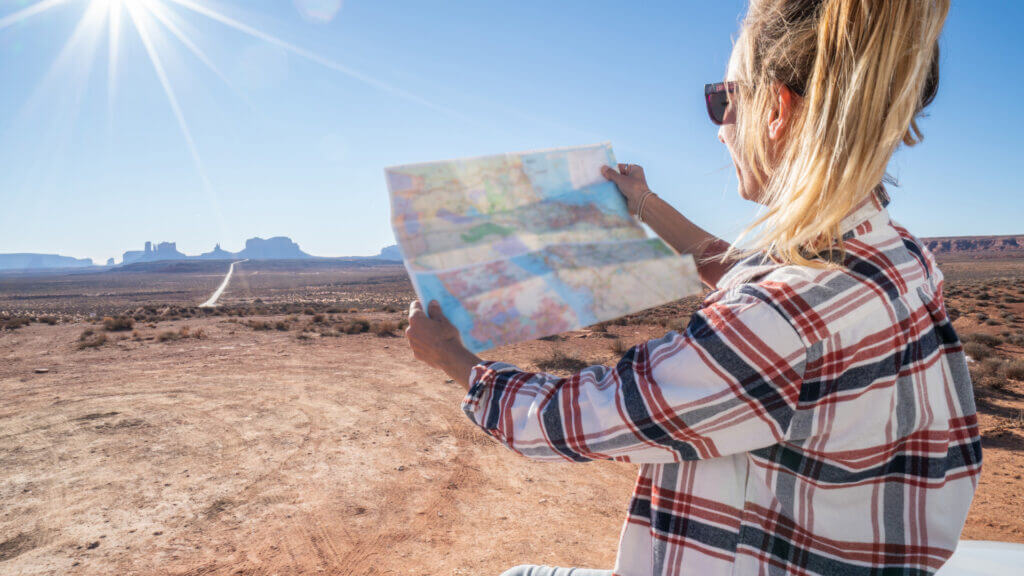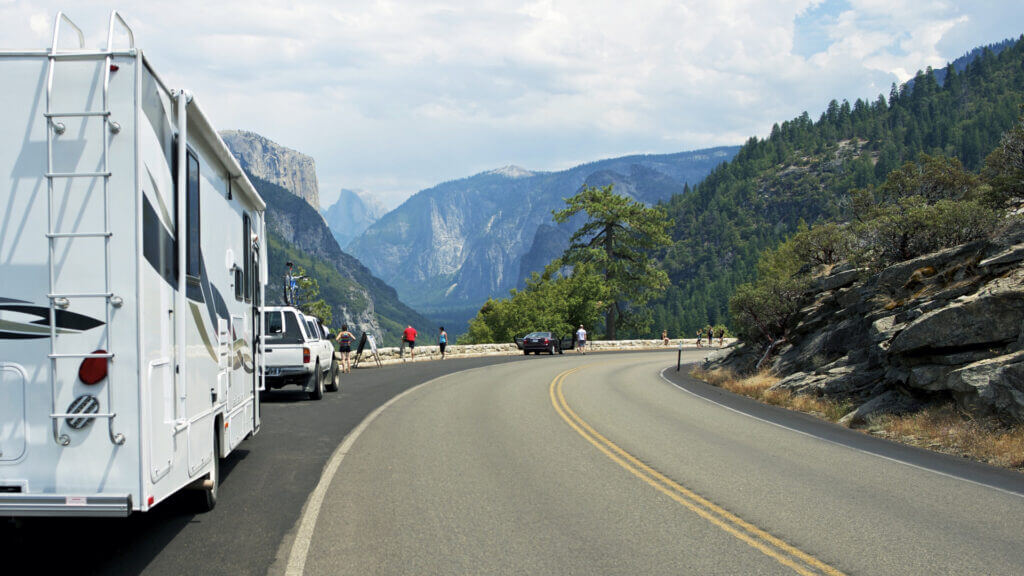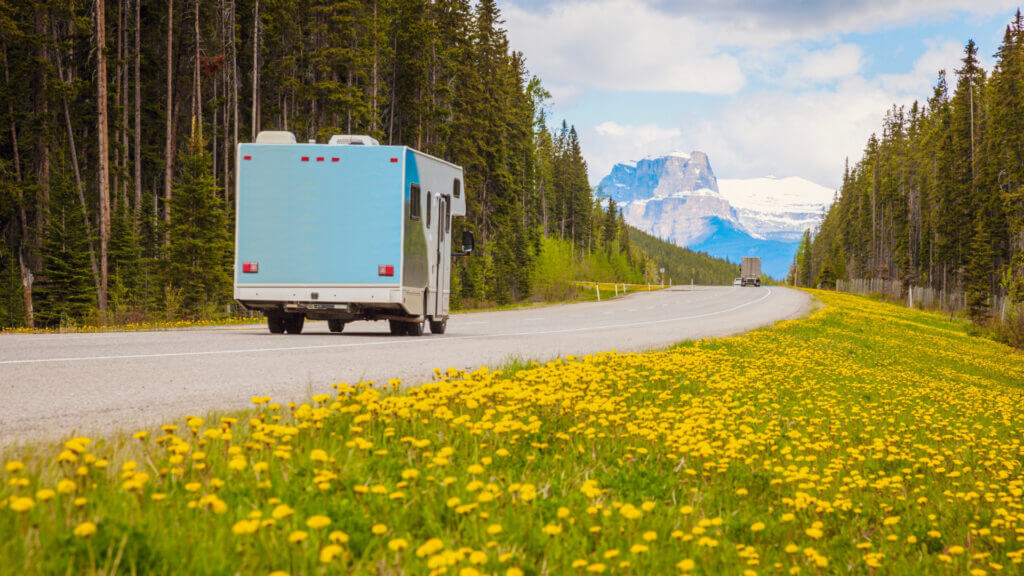Table of Contents Show
An RV trip to all 50 states is the traveling version of the quintessential American dream. Seeing every state is an experience that families and individuals will never forget. However, before you hit the road, we have a few resources that might be useful. Let’s get started!
How to Plan an RV Trip to All 50 States
Planning an RV trip is no small undertaking, but an RV trip across the entire country is a whole different ballgame. The research you do while planning can take your trip to another level.
During the research phase of your planning, you’ll learn more than you ever imagined about states and places you’ve never visited.
Once you have done adequate research, you can move on to the next phase of planning this memorable trip, planning your route. You don’t want to waste time backtracking because you didn’t plan!
Using the information you collected during the research can help you place each pin while planning your route.
The tricky part of planning your route is realizing it’s not possible to see everything you’ve discovered during your research.
The next couple of phases involve determining how long you will stay and where you will stay. In some instances, you’ll have more control over this than in others.
Whether it’s a limit on how long you can stay in a campground or the availability of sites, you’ll want to make sure you have a place to rest at the end of the day.
First: Plan Your Route
As we stated earlier, backtracking for a cross-country road trip is never something anyone wants to do. You also don’t want to find yourself traveling on roads or bridges that are not RV-friendly.
Traveling in an RV can be stressful, but this stress is magnified when you’re lost or on a road not approved for RVs.
When planning your route, you might find it beneficial to find centralized locations to stay and drive to multiple destinations. Whether you want to see one of the National Parks or an exciting roadside attraction, you can drive to them.
RV campsites are often pricier and more crowded around popular tourist locations. If you’re looking for more space and don’t mind traveling, staying away from them is a great way to save some money and see more of the area.
When planning your route, allow room for flexibility. You may discover later that a campground is full or that you want to extend your time at a location. A little bit of flexibility in your schedule helps take the stress off when unexpected events happen, or circumstances change. Both unexpected events and circumstances changing are ordinary happenings while RVing.
Pro Tip: Use an RV travel planning app like RV Life Trip Wizard that will plan an RV safe driving route and help estimate fuel costs.

Determine Length Of Stay in Each State
How long you stay in a state is primarily determined by how much you plan to do in each state. You may even find that for some states, you’re simply passing through them on your way to your next adventure.
The wonderful thing about RVing is the freedom that it allows. The time you stay at a location depends on how long you are allocating for your adventure.
Some travelers are constantly on the move and can check off all the states in less than a year. If the time you have allotted for your trip is more flexible or indefinite, you can choose to stay in a state for months instead of a couple of days.
Plan When to Book Campgrounds
You’ll quickly realize that campgrounds around popular destinations fill up quickly, sometimes a year or more in advance. This is another reason we stated earlier to have flexibility in your route when planning your trip. The unique camping location you discovered while researching may be incredible but also incredibly popular.
You’ll also find that booking a campsite during the week can be relatively easy, but many campgrounds fill up on weekends and holidays. Many families plan annual camping trips around major holidays, and campsites become extremely limited.
We’ll share with you a few resources that will aid you in finding and selecting campgrounds later, but for now, let’s look at what to do in each state.
Have an Idea of What to See and Do in Each State
Each state offers its own unique adventures and spectacles. Be sure you have an idea of what you want to experience before you accidentally pass it by!
Another great thing about adventuring and exploring is that you have the freedom to customize it for those you’re adventuring with.
Optimize your time and energy by doing activities that you enjoy in each state. If you enjoy being outdoors, hiking, fishing, and kayaking are all great ways to fill your time.
If you’re more interested in museums or educational opportunities, there’s plenty of those to find.

Renting an RV vs. Bringing Your Own
RVs are incredibly expensive and are a significant investment, especially if you’ll be needing a tow vehicle as well. RVs also aren’t known for having a great return on investment or resell value. Deciding whether it is better to rent or bring your own will widely be determined by your circumstances.
If you already own an RV or plan to continue using it after your adventures are complete, bringing your own may be a great option. It will allow you to customize and make the RV as comfortable as possible for those in your crew.
While owning an RV can be expensive, renting an RV can be equally as expensive and more restricting. You’ll not only be paying a daily fee for renting an RV but often per mile. There’s also usually a fee involved for any accessories that are provided for use as well.
Renting an RV for an extended period can get very expensive, but you no longer have an RV to worry about selling or maintaining at the end of your trip. It’s a tough decision to make!

Do You Need a Tow Vehicle?
Those who opt for a driveable RV often tow a vehicle behind them. This makes it easier to see and experience area attractions and complete everyday tasks such as grocery shopping and any errands.
Other RVers opt for a towable RV, such as a fifth wheel, which requires a vehicle to tow the RV and its contents safely. You should consult your vehicle’s owner’s manual to see whether your vehicle can tow an RV. Exceeding the recommended towing limits of your RV puts not only yourself and passengers but other drivers and passengers at risk.
Planning Roads and Gas Stations
Not all roads are created equal; some aren’t designed for larger vehicles or RVs. You’ll want to use an RV or trucker GPS or navigation system when towing. This will not only help you get from point A to point B but also get there safely. Low clearance bridge and overhangs aren’t something you regularly have to consider in a standard passenger vehicle, but you most definitely have to when towing or driving a large RV.
Speaking of low clearance and overhangs, did you know gas stations aren’t often designed with RVs in mind?
Getting fuel, especially gas, can be incredibly difficult in the wrong circumstances. You’ll want to scout out in advance using your GPS or navigation app to verify you’ll have the room and space required to maneuver your RV in the gas station.
Even if there is room to maneuver, always keep an eye on dips and inclines, resulting in an RV hitting the road.
If you require diesel, using the big truck lanes is generally acceptable as long as you get out of the way as soon as you’re finished.
Helpful RV Apps for an RV Trip to All 50 States
Technology has made traveling not only more popular but more effortless than ever before. Here are a handful of resources you can have in the palm of your hand to make your RV trip a little easier.
Campendium
Whether you use the Campendium website or the app, this resource will help you scout out places to stay. You can set a wide variety of filters that help narrow down the possibilities of your next camping location.
The extensive community of users regularly providing reviews of campsites helps get a better picture of what to expect for each location. For a nominal fee, you can support Campendium and gain access to filter results based on cell phone signals as well. This is a must-have for planning your RV trip!
Allstays
The Allstays camp and RV is the #1 selling, #1 ranked, and #1 reviewed on the iOS platform. Whether you’re looking for a campground, RV park, or any related services, with or without internet, you’ll find it in the Allstays app. The app continues to evolve and grow with every update, but it’s easy to see why RVers love it.
Gasbuddy
Gasbuddy uses your phone’s GPS location to identify the nearest gas stations. User-submitted data is used to provide a range in prices for the area, emphasizing the best value. Users can easily click on the gas station of their choice and get directions.
Driving a diesel truck? No problem! Gasbuddy allows users to pick their fuel type preference and remembers for future searches.
iOverlander
The iOverlander app is available on both Android and Apple operating systems. You can easily find nearby places to stay via the map or list views. You can even view the amenities, descriptions, and reviews of each place. If you have a favorite site that’s not listed, you can add it to their database or provide your review.
The Dyrt
The Dyrt is an excellent resource that offers a trip planner to aid you in planning your route but also adjusts based on your camping style and driving preferences. Using the map layers features, you’ll quickly find free and dispersed camping on public grounds.
While many apps rely on cell service, with The Dyrt, you’ll have access to campgrounds, your saved trips, lists, and even downloaded maps. This app is subscription-based, but we think it’s one worth considering, especially for a cross-country trip.
Ultimate RV Checklist
Bad things happen when you miss steps, especially when it comes to your RV. RVers created the Ultimate RV Checklist app to help other RVers take the stress and uncertainty out of several repetitive tasks RVers often face.
This app will give you more confidence and assurance during the various RVing processes you encounter. The $1.99 price tag will quickly pay for itself if it helps you avoid even the smallest of RVing mistakes.
Pro Tip: If you’re looking for even more awesome RV apps, check out 17 Apps Every RVer and Camper Should Have.
Conclusion
While it is theoretically possible to ship your RV to Hawaii, it’s costly. We like the idea of taking the money saved on importing your RV and using Hawaii as a celebration trip for seeing the other 49 states in your RV. Catch a few waves, eat some pineapple and visit some of their incredible national parks. Which state do you think is the best to explore in an RV? Let us know in the comments!







How did you drive your RV to Hawaii. Just curious.
An amazing state to RV in is Arkansas!